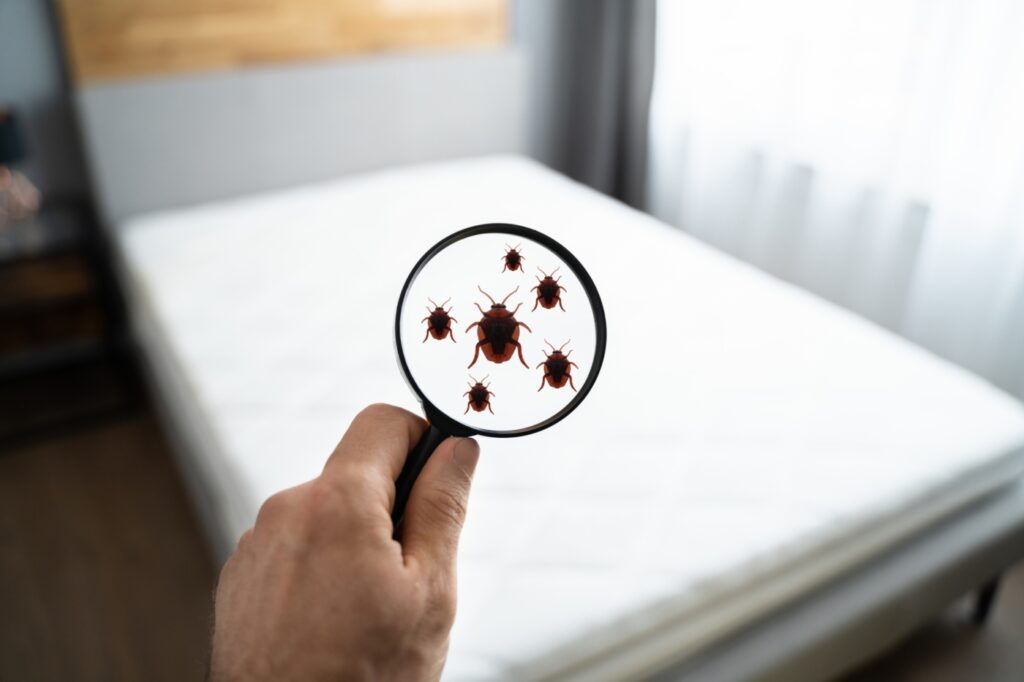
Bedbugs, once associated with crowded and dirty living quarters, have become a more widespread problem in recent years. They can be found anywhere – from public transportation to nice hotels. Like most unwelcome guests, they are notoriously difficult to get rid of.
These bloodsucking beasties live anywhere humans live. Although they can feed on other mammals and birds, they prefer human blood. They are wingless, red to reddish-brown, with a flat oval body that is slightly less than 1/4-inch long. Although their size makes them easy to identify, they are good at hiding if you’re not looking for them.
Usually, the first sign of a bedbug problem is the appearance of red, itchy bites hours after exposure. Sensitive individuals can develop severe dermatitis from these bites, resulting in a painful, itchy, persistent rash.
Bedbugs can feed undetected because they usually attack at night when their host (you) is sleeping, and their saliva contains a natural anesthetic that prevents you from feeling their bites.
Related Articles
Gardeners, some tips for managing the potential plant bounty of a seed rack
What’s happening with your citrus trees? Readers share their stories
5 things to do in the garden this week: Get planting those vegetables
Former ‘Clean House’ host Mark Brunetz talks about his Scandalabra design podcast
What to know about growing rhubarb
Once you suspect that you’ve been feasted upon, you’ll probably notice the signs of bedbug infestation. Look along the mattress seams and tufts, between the box springs and the bed frame, behind wall decorations and along baseboards. Bedbugs can usually be found within 6 feet of the bed. Other signs of bedbugs include the presence of small, reddish-brown spots on the sheets. In cases of extreme infestation, a foul “meaty” odor may be present.
Bedbugs can go without feeding for a very long time. Depending on the temperature, they can survive over a year without food. Forget about starving them out!
In cases of a small, or limited, infestation, bedbugs might be eliminated by thorough vacuuming and steam cleaning. Although there are many products available to the homeowner that are labeled for use against bedbugs, none of them have been proven completely effective. If the infestation is moderate or severe (or you just want to be absolutely sure), professional pest control is your best bet. Licensed exterminators have access to the most effective insecticides and are a most valuable resource in this battle.
Clothing and bedding that is infested can be washed on a high temperature setting to eliminate bugs and their eggs. Exposure to temperatures above 140F for 2 hours (or 130F for 3 hours) can destroy bedbugs and their eggs, but this high temperature treatment probably should be done professionally so that you don’t set your house on fire.
How do you avoid this problem in the first place? There are several precautions that will either prevent or limit the likelihood of an infestation. Obviously, don’t bring home furniture that you found on the freeway. If you buy used furniture, inspect it thoroughly and have it steam cleaned if possible. When staying in a hotel, keep your luggage in the bathroom. Inspect bedding as soon as you get to your room (and certainly before climbing into bed!). When returning from a trip, launder everything and store suitcases away from sleeping areas.
Have questions? Email gardening@scng.com.
Looking for more gardening tips? Here’s how to contact the Master Gardener program in your area.
Los Angeles County
mglosangeleshelpline@ucdavis.edu; 626-586-1988; http://celosangeles.ucanr.edu/UC_Master_Gardener_Program/
Orange County
ucceocmghotline@ucanr.edu; 949-809-9760; http://mgorange.ucanr.edu/
Riverside County
anrmgriverside@ucanr.edu; 951-683-6491 ext. 231; https://ucanr.edu/sites/RiversideMG/
San Bernardino County
mgsanbern@ucanr.edu; 909-387-2182; http://mgsb.ucanr.edu/
Related Articles
Gardeners, some tips for managing the potential plant bounty of a seed rack
What’s happening with your citrus trees? Readers share their stories
5 things to do in the garden this week: Get planting those vegetables
Former ‘Clean House’ host Mark Brunetz talks about his Scandalabra design podcast
What to know about growing rhubarb
